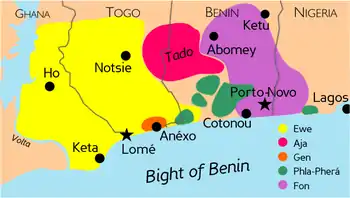Fon language
Fon (fɔ̀ngbè or fõbè, pronounced [fɔ̃̀ɡ͡bē][2]) is spoken mainly in Benin by approximately 1.7 million speakers, by the Fon people. Like the other Gbe languages, Fon is an isolating language with an SVO basic word order.
| Fon | |
|---|---|
| fɔ̀ngbè/fõbè | |
| Native to | Benin, Nigeria, Togo |
| Ethnicity | Fon people |
Native speakers | 2.2 million (2000–2006)[1] |
| Latin | |
| Official status | |
Official language in | |
| Language codes | |
| ISO 639-2 | fon |
| ISO 639-3 | fon |
| Glottolog | fonn1241 Fon language |

Dialects
The standardized Fon language is part of the Fon cluster of languages inside the Eastern Gbe languages. Hounkpati B Christophe Capo groups Agbome, Kpase, Goun, Maxi and Weme (Ouémé) in the Fon dialect cluster, although other clusterings are suggested. Standard Fon is the primary target of language planning efforts in Benin, although separate efforts exists for Goun, Gen, and other languages of the country.[3]
To date, there are about 53 different dialects of the Fon language spoken throughout Benin.
Phonology

Fon has seven oral vowel phonemes and five nasal vowel phonemes.
| Oral | Nasal | |||
|---|---|---|---|---|
| front | back | front | back | |
| Close | i | u | ĩ | ũ |
| Close-Mid | e | o | ||
| Open-mid | ɛ | ɔ | ɛ̃ | ɔ̃ |
| Open | a | ã | ||
| Labial | Coronal | Palatal | Velar | Labial -velar | ||||||
|---|---|---|---|---|---|---|---|---|---|---|
| "Nasal" | m ~ b | n ~ ɖ | ||||||||
| Occlusive | (p) | t | d | tʃ | dʒ | k | ɡ | kp | ɡb | |
| Fricative | f | v | s | z | x | ɣ | xʷ | ɣʷ | ||
| Approximant | l ~ ɾ | ɲ ~ j | w | |||||||
/p/ only occurs in linguistic mimesis and loanwords, though often it is replaced by /f/ in the latter, as in cɔ́fù 'shop'. Several of the voiced occlusives only occur before oral vowels, while the homorganic nasal stops only occur before nasal vowels, indicating that [b] [m] and [ɖ] [n] are allophones. [ɲ] is in free variation with [j̃]; Fongbe therefore can be argued to have no phonemic nasal consonants, a pattern rather common in West Africa.[lower-alpha 1] /w/ and /l/ are also nasalized before nasal vowels; /w/ may be assimilated to [ɥ] before /i/.
The only consonant clusters in Fon have /l/ or /j/ as the second consonant; after (post)alveolars, /l/ is optionally realized as [ɾ]: klɔ́ 'to wash', wlí 'to catch', jlò [d͡ʒlò] ~ [d͡ʒɾò] 'to want'.
- Tone
Fon has two phonemic tones, HIGH and LOW. High is realized as rising (low–high) after a voiced consonant. Basic disyllabic words have all four possibilities: HIGH–HIGH, HIGH–LOW, LOW–HIGH, and LOW–LOW.
In longer phonological words, such as verb and noun phrases, a high tone tends to persist until the final syllable; if that syllable has a phonemic low tone, it becomes falling (high–low). Low tones disappear between high tones, but their effect remains as a downstep. Rising tones (low–high) simplify to HIGH after HIGH (without triggering downstep) and to LOW before HIGH.
/ xʷèví-sà-tɔ́ é kò xɔ̀ àsɔ̃́ wè / [ xʷèvísáꜜtɔ́ ‖ é kó ꜜxɔ̂ | àsɔ̃́ wê ‖ ] fish-sell-aɡent s/he PERF buy crab two - Hwevísatɔ́, é ko hɔ asón we.
- "The fishmonger, she bought two crabs"
In Ouidah, a rising or falling tone is realized as a mid tone. For example, mǐ 'we, you', phonemically high-tone /bĩ́/ but phonetically rising because of the voiced consonant, is generally mid-tone [mĩ̄] in Ouidah.
Orthography
The Fon alphabet is based on the Latin alphabet, with the addition of the letters Ɖ/ɖ, Ɛ/ɛ, and Ɔ/ɔ, and the digraphs gb, hw, kp, ny, and xw.[5]
| Majuscule | A | B | C | D | Ɖ | E | Ɛ | F | G | GB | H | HW | I | J | K | KP | L | M | N | NY | O | Ɔ | P | R | S | T | U | V | W | X | XW | Y | Z |
|---|---|---|---|---|---|---|---|---|---|---|---|---|---|---|---|---|---|---|---|---|---|---|---|---|---|---|---|---|---|---|---|---|---|
| Minuscule | a | b | c | d | ɖ | e | ɛ | f | g | gb | h | hw | i | j | k | kp | l | m | n | ny | o | ɔ | p | r | s | t | u | v | w | x | xw | y | z |
| Sound (IPA) | a | b | tʃ | d | ɖ | e | ɛ | f | ɡ | ɡb | ɣ | ɣw | i | dʒ | k | kp | l | m | n | ɲ | o | ɔ | p | r | s | t | u | v | w | x | xw | j | z |
Tone marking
Tones are marked as follows:
- Acute accent marks the rising tone: xó, dó
- Grave accent marks the falling tone: ɖò, akpàkpà
- Caron marks falling and rising tone: bǔ, bǐ
- Circumflex accent marks the rising and falling tone: côfù
- Macron marks the neutral tone: kān
Tones are fully marked in reference books, but not always marked in other writing. The tone marking is phonemic, and the actual pronunciation may be different according to the syllable's environment.[6]
Sample text
From the Universal Declaration of Human Rights
- GBETA GBƐ Ɔ BI TƆN EE ƉƆ XÓ DÓ ACƐ E GBƐTƆ ƉÓ KPODO SISI E ƉO NA ƉÓ N'I LƐ KPO WU E WEXWLE
- Ee nyi ɖɔ hɛnnu ɖokpo mɛ ɔ, mɛ ɖokpoɖokpo ka do susu tɔn, bɔ acɛ ɖokpo ɔ wɛ mɛbi ɖo bo e ma sixu kan fɛn kpon é ɖi mɛɖesusi jijɛ, hwɛjijɔzinzan, kpodo fifa ni tiin nu wɛkɛ ɔ bi e ɔ, ...
Use
Radio programs in Fon are broadcast on ORTB channels.
Television programs in Fon is shown on the La Beninoise satellite TV channel.[7]
French used to be the only language of education in Benin, but in the second decade of the twenty first century, the government is experimenting with teaching some subjects in Benin schools in the country's local languages, among them Fon.[1][8][9][10]
Notes
- This is a matter of perspective; it could also be argued that [b] and [ɖ] are denasalized allophones of /m/ and /n/ before oral vowels.
References
- Fon at Ethnologue (18th ed., 2015)
- Hildegard, Höftmann (2003). Dictionnaire fon-français : avec une esquisse grammaticale. Michel Ahohounkpanzon. Köln: Rüdiger Köppe Verlag. pp. 179. ISBN 3896454633. OCLC 53005906.
- Kluge, Angela (2007). "The Gbe Language Continuum of West Africa: A Synchronic Typological Approach to Prioritizing In-depth Sociolinguistic Research on Literature Extensibility" (PDF). Language Documentation & Conservation: 182–215.
- Claire Lefebvre; Anne-Marie Brousseau (2002). A Grammar of Fongbe. Walter de Gruyter. pp. 15–29. ISBN 3-11-017360-3.
- Hildegard, Höftmann (2003). Dictionnaire fon-français : avec une esquisse grammaticale. Michel Ahohounkpanzon. Köln: Rüdiger Köppe Verlag. pp. 19. ISBN 3896454633. OCLC 53005906.
- Hildegard, Höftmann (2003). Dictionnaire fon-français : avec une esquisse grammaticale. Michel Ahohounkpanzon. Köln: Rüdiger Köppe Verlag. pp. 20. ISBN 3896454633. OCLC 53005906.
- "BTV - La Béninoise TV - La Béninoise des Télés | La proximité par les langues". www.labeninoisetv.net (in French). Retrieved 2018-07-03.
- Akpo, Georges. "Système éducatif béninois : les langues nationales seront enseignées à l'école à la rentrée prochaine". La Nouvelle Tribune (in French). Retrieved 2018-07-03.
- "Reportage Afrique - Bénin : l'apprentissage à l'école dans la langue maternelle". RFI (in French). 2013-12-26. Retrieved 2018-07-03.
- "Langues nationales dans le système scolaire : La phase expérimentale continue, une initiative à améliorer - Matin Libre" (in French). Retrieved 2018-07-03.
Bibliography
- Hildegard, Höftmann (2003). Dictionnaire fon-français : avec une esquisse grammaticale. Michel Ahohounkpanzon. Köln: Rüdiger Köppe Verlag. ISBN 3896454633. OCLC 53005906.
External links
| Fon language test of Wikipedia at Wikimedia Incubator |
- A Facebook application to use and learn the Fon language, developed by Jolome.com
- The first blog totally in Fongbe. An access to a Fongbe forum is given
- Journal of West African Languages: Articles on Fon
- Manuel dahoméen : grammaire, chrestomathie, dictionnaire français-dahoméen et dahoméen-français, 1894 by Maurice Delafosse at the Internet Archive (in French)